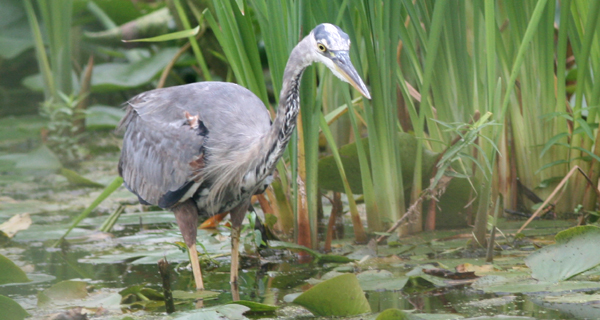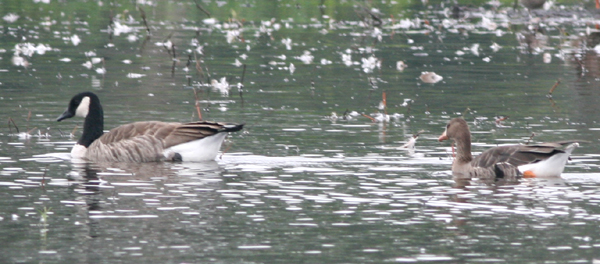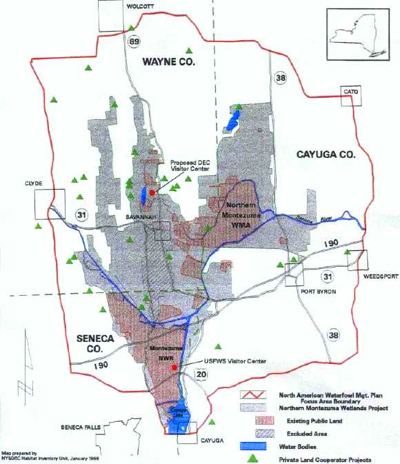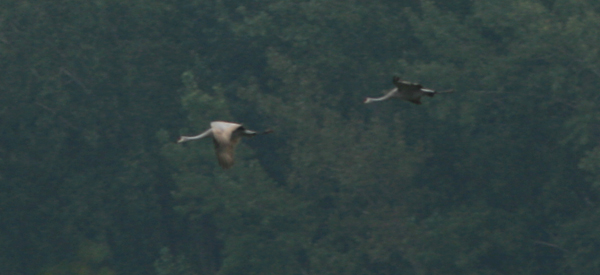This weekend two-thirds of the 10,000 Birds triumvirate participated in the 12th Annual Montezuma Muckrace. I’m pleased to report that we lived to tell the tale. Corey and I, accompanied by ace birders Jory Langner and Will Raup, ushered in a shining new era of competitive Big Day birding, the debut of the 10,000 Birds Butcher Birders! Well, perhaps our collective first crack at the Montezuma Muckrace wasn’t particularly glorious, but it was gritty as well as a heck of a lot of fun.
Our quest was a simple one: identify by sight or sound as many wild bird species as possible across the enormous, brilliantly biodiverse Montezuma Wetlands Complex. For those of you who haven’t yet had the pleasure of visiting, the Montezuma Wetlands Complex, a 34,000-acre region at the northern end of Cayuga Lake sprawling across Cayuga, Wayne, and Seneca Counties in Central New York, is a major migratory stopover for waterfowl, shorebirds, and passerines. It is also, if I haven’t gotten the point across, rather expansive…
Teams in last year’s Muckrace tallied a combined 177 species, a remarkable number for any North American region, particularly one inland. Based on that, I projected 130 species for the Butcher Birders. Did our reality match the fantasy? Rather than enumerate each and every sighting, I’ll share some vignettes from notable moments throughout our 24-hour odyssey, starting with the our start at 8:00PM on Friday, September 12:
8:00PM – Our plan was to prowl Montezuma’s Main Pool for bitterns, rails, and owls. Although an American Bittern flew overhead 15 minutes earlier, we could not relocate the bird once the competition officially started. Corey cracks rocks together in a futile attempt to attract Virginia Rails.
10:00PM – We depart Montezuma for the night. The less said about this ineffectual leg of our race, the better.
4:30AM – After a few hours of rest in Rochester, we return to the race by making a predawn run to Howland Island. This segment of the Northern Montezuma Wildlife Management Area is reputed to be rich in owls and migratory songbirds. The former turns out to be true; Jory whistled up an Eastern Screech Owl with his uncanny imitation while Corey managed to taunt a Barred Owl to respond to his own strangled call. As far as the latter goes, we had a difficult time find much more than the ubiquitous cardinals, crows, chickadees, and titmice. Let me stress, we had a very difficult time.
7:30AM – As we navigate Howland Island’s tortuous, tangled tracks, we begin to truly appreciate the contributions of our unofficial fifth team member. Jory’s preternaturally calm and wise GPS system, nicknamed Lola, facilitates this particular brand of bird chasing marvelously. Many of the roads throughout the Howland Island complex are so primitive as to barely deserve the name but Lola gets us around flawlessly.

At least some species can be counted on during the Muckrace
10:00AM – We depart Howland Island with only owls and common birds in our metaphorical pockets. Behind pace, we need to pick up shorebirds. The town of Savannah is home to many of the kinds of fields American Golden Plovers love. Much to our surprise, it’s child play to pick out plenty of gorgeous adults and juveniles amidst the teeming Killdeer. This is a life bird for me; obviously, I am psyched!
11:00AM – From one pool to another, we rack up shorebirds, waterfowl, and raptors. Unfortunately, the great voids in our list where migratory songbirds should be are making us nervous. Bucking conventional wisdom, which holds that seeking out warblers at midday is a fool’s errand, we strike out for the Esker Brook trail.
High Noon – Make that “struck out at Esker Brook” since we left with as many warblers as we arrived with. At least we picked up a couple of woodpeckers. Still, the habitat looks great so we’re hopeful that a later visit will be fruitful.
12:30PM – The scant scouting our farflung team was able to muster has paid off handsomely in scattered prizes like Snow Goose and Peregrine Falcon. After checking all of these off our list, we finally make it to the Main Pool. I imagined that this area, the centerpiece of the Montezuma refuge, would play a more pivotal role in our muckrace. If I’ve learned anything from this adventure, it’d definitely that there’s far more to Monte than the Main Pool.
1:00PM – Another thing I expected was that there would be a lot of downtime during a Big Day. That never happened for us. We barely managed to create and choke down sandwiches in the parking lot before getting back to business. As we all scope the shallow marsh, I find myself humbled by the tremendous talent assembled for this competition. Team after team displays incredible patience and perceptiveness in delving the clandestine diversity in a flock of ducks. Sure, they all look like Mallards from a distance, but with enough effort, one might tease out a Redhead here or a wigeon there. We do very well on ducks but so, it seems, does everybody else.
2:30PM – By this time, we’ve scored lots of sandpipers along with a very special target bird. The Greater White-fronted Goose that tarried here a couple of weeks back when I attained my first Sandhill Cranes would be a life bird for Will and an ABA lifer for Corey. Luckily for both posterity and our day lists, this wild goose chase ended successfully. As a bonus, the pair of cranes treated us to a fortuitous flyover. If I recall correctly, Jory burst out into song at the sight. We picked up a much-needed boost from those birds!

Corey and Will’s special goose (on the right)
4:00PM – We lost a lot of time turning in our paperwork at the last minute. In addition, calamity befell Corey, though the tale of it is not mine to tell. But with only a few practical hours of birding left, it was time to really work for passerines.
5:30PM – Really working for passerines didn’t exactly work. Esker Brook was deathly still. With only a Magnolia Warbler to show for our painstaking efforts, our fourth and final warbler species of the day, we were faced with the harsh reality that we very well might not be breaking double digits. Call it desperation or iron will, but we abort our songbird attempts and scramble for shorebirds, waterfowl, and raptors.
6:00PM – Did we really go all day without seeing an Osprey? At Montezuma?!? There’s an Osprey on this year’s Muckrace t-shirt but apparently none over Montezuma.
6:30PM – The American Golden Plovers were a special treat during the morning hours. Now we’re back in Savannah desperately trying to turn one into a Black-bellied Plover. Despite Corey’s assertion that, by the law of averages, at least one of the six juveniles we’re scanning is a black-belly, they all come up golden.
6:45PM – Stalled at 99, we return to a previously productive pool to scan for dowitchers. They didn’t turn up but species #100 did fly overhead. I have never been so elated to observe Common Grackles in all my life!
7:30PM – Other teams turned us on to the entirely unexpected Red Knot at the Montezuma Audubon Center so, with 30 minutes to spare, we swept that along with a welcome Black-bellied Plover. After this, we immediately fled from the ravenous mosquitoes, official checklist in hand, to the safety of the Audubon Center. 23 hours and 30 minutes after we began, it was all over but the counting.
How did the 10,000 Birds Butcher Birders fare? Well, we didn’t win, as our 102 species was at least two migrant passerine flocks shy of the victorious tally of 130 species. However, we certainly didn’t embarrass ourselves. For first time Muckracers, our count was respectable. More important, our team held together admirably under pressure. Corey, Jory, and Will were sterling teammates in the face of some of the worst fall warbler conditions conceivable. It’s also worth noting how sporting many of the other teams were in sharing news and sightings. I’ve heard Big Days can be cutthroat but this crowd was clearly connected by a love of birds more enduring than a single day’s effort. Special thanks go to my fun new friends from the Rochester Birding Association team and John Ballou of the Three Two Muckateers. All in all, this was a brilliant day that we Butcher Birders can’t wait to surpass next year.
And now to sleep!















Sounds like fun! I’m coming over for the next one guys…
Sounds like a great day. Any time you can spend a full day of full-bore birding with friends is a good day. The addition of a little competition makes it even more fun.
Oh, the calamity!
More on the muckrace will be coming soon…
Hardest Day birding… Ever!
And really not enough can be said about Lola!
And Jory’s “Crane Dance” will go down as one of my greatest birding moments ever.
Thanks for sharing your day with us! Wish we would have run into you guys sooner, but in the frenzy of the day, it’s no real surprise. We really appreciate you guys tipping us off to the Black Crowned Night Heron, we had lost a little faith, because we kind of got a cold shoulder from some other teams to the point we were starting to get bummed that we were the only team trying to have a good time and not just being “cutthroat” birders. We ran into one team and I friendly asked if they were having fun, and they told me, “No, this is serious business.” I mean come on!
So we had a blast, and though we are the kind of team that doesn’t get out of double digits (yet) we try our best, try to raise some $, and try to have a fun day.
Hope we can share some info with you next year again, hopefully when our team is back up to full strength.
John (of the Two Muckateers)
Gl
We were still cracking our terrible jokes more than 50 hours later. And laughing at them too!
Lola is now resting comfortably.